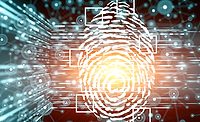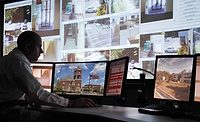Media features include surface quality, durability and built-in security elements.
Printer capability encompasses high-resolution graphics and reliable barcodes, plus covert features printed at the time of issue.
Database verification consists of a central archive of cardholder data, including a photo, personal statistics, employee number, date, time and place of issue.
Card volume
The number of cards to be printed – and how quickly the cards must be printed – will help determine the type of printer required. An organization printing only 20-or-so cards per week on-site and on-demand can easily get by with a single-sided printer, even if printing on both sides of the card. Putting the cards through for a second printing pass isn’t overly burdensome when there are only a small number of cards to print.However, for a large organization with a need to print more than a few dozen cards a week, a dual-sided printer with an integrated flip-over mechanism becomes essential for creating cards in a timely manner.
A good rule of thumb: if printing less than 12,000 cards a year, it is possible to get by with a smaller, single-sided printer. If printing more than 12,000 but less than 30,000, a printer with more advanced features, such as dual-sided printing, is advised. And if printing more than 30,000 cards, it is time to look at the big guns. For instance, a top-of-the-line printer that prints on both sides and includes a dual-sided laminating station can run 120 cards an hour.
Card function
The next consideration is how the card will be used. Will it be strictly for photo identification cards, or badges that will double as access control credentials? Will they be proximity, smart chip or magnetic swipe cards? Will the printer be linked to a database? How much security should be built into the card itself?Today’s printers run from space-saving, simple monochrome units that can personalize a pre-printed color card and add a barcode, to high-end units that render razor-sharp color graphics and tamper-proof security features. Such features include holographic image lamination and other security images that thwart would-be counterfeiters. Printer options also include magnetic stripe and smart card chip encoders that provide endless possibilities for card uses.
To prevent counterfeiting, alteration or duplication, there are many techniques that companies can employ with digital printers. Multiple security images or holograms are one such example; a security image alone increases the difficulty of counterfeiting – two makes it at least twice as hard. Multiple screenings of the same photograph – the norm on drivers’ licenses – increase integrity. Unique graphic identifiers, such as allowing only the red-bordered cardholders to access an area, can help differentiate security levels.
End users should consider card stock with pre-printed security features, including ultraviolet-visible text and graphics that are available in two colors, green and blue. With micro-printing, text can be added to a user’s specifications, with deliberate random font changes and misspellings if desired. Character height is just 0.005 inches (0.125mm). Pre-printed serial numbers can also be incorporated into card stock. Laser etching is another option.
Fine-line Guilloche patterns with hidden micro-text are aimed at foiling counterfeiters, and micro-printing of text and miniature graphic elements are also difficult to duplicate. An over-laminate film adds security to the printed ID card. The inner surface of the laminate can be pre-printed with OVI ink or UV-visible ink in one, two or three colors. And last, but not least, today’s high-tech printers can also laminate with holographic metallization, including embossed micro-text.
It is also important to keep track of card transactions in the printer’s host computer. Such data sets can provide a means for security officers to validate the card by comparing a photo ID card with this centrally located information.
Card serialization adds security. Printers with the magnetic stripe encoder, barcode reader, proximity encoder and smart card contact options can be set up to function only with serial numbered card stock, and recorded.
All cards supplied to an organization using this system are pre-printed on the front or back with a serial number, which is also recorded on the card’s credential medium, such as magnetic stripe, proximity chip or smart card IC. The ID card printer is configured to accept only serial numbered cards, and will eject, without printing, any card without the appropriate encoding. If a valid serial number is detected, the card is printed in the usual way.
The serial number read from the credential medium is recorded in the printer’s host computer, where it is linked with the license or employee number and other data such as date, time and location. This data set is available for uploading at any time to the organization’s central database.
As a result, the security officer can read, on-the-spot, an ID card that is linked in the database to a serial number without any special equipment. When transmitted to the central database, the serial number can, in turn, trigger a download to a local terminal. Now, in addition to the usual comparison of photo and subject, it is easy to instantly check the correlation of serial number and credentials.
Ease-of-use
A card printer needs to be especially easy to use if it will be operated by more than one person, or by someone who is not overly computer and printer savvy.User-friendly printer features to look for include self-feeding devices, easy access clamshell designs, easy-to-use ribbon cartridge systems, quick reference guides and printer drivers with built-in installation wizards. Other user-friendly features include low maintenance designs, LED indicators for instant printer status and self-cleaning cartridges that remove dust on cards before printing, minimizing problems caused by contamination.
A printer with radio frequency identification (RFID) technology takes both simplicity and security a step further. Intelligent printing systems incorporate RFID technology that minimizes the need for user intervention. For example, RFID enables automatic driver configuration, automatic ribbon-type detection, enhanced image quality, ribbon low notification, and more accurate color printing.
RFID technology also ensures that only authorized users can access a printer. Printers are configured to reject any ribbon that does not have a specific RFID-tagged ribbon installed.
Printing locations
For large organizations and those with several far-flung departments, offices or campuses, another factor to consider is whether to print all the cards centrally, in a main office or headquarters, or if the cards will be printed on-site. The essential question is, how quickly do cards need to be in the hands of their users?A large organization with several campuses may print all of its cards in one large batch from a central printing room. However, another may choose to purchase a printer for each campus, so that cards can be created on-demand. Organizations that use an Ethernet network can also take advantage of printers with new built-in Ethernet capabilities.
Built-in Ethernet functionality gives users greatly enhanced operational efficiency, especially for large facilities with multiple printers such as school districts, casinos, resorts and membership clubs. Having multiple printers on the network allows printing to continue even while a ribbon is being replaced on one printer. This redundancy also increases overall system reliability, because any PC can print to any card printer on the network. That means an immediate rollover to working machines in case of technical issues with a PC workstation or a printer is possible with this configuration.
Card durability
Last, but not least, before purchasing a printer an organization should determine how long it expects the cards to last. Will they be replaced annually, or less often?Most driver’s licenses and other hard cards found in wallets and purses have the same physical dimensions. This is the standard CR-80 card, measuring about 3.375 by 2.125 inches (85.5mm x 54mm) and 30 mil (0.75mm) thick.
As a guideline, an un-laminated card can be expected to withstand 300 swipes through a magnetic stripe reader before it is scratched. After laminating, however, the same card can handle up to 50,000 swipes before being damaged. Most leading card printer manufacturers have the capability to apply protective overlay varnish with or without holograms. This application is adequate for cards that need to last less than two years.
Depending on volume and how quickly an organization needs to print cards, there are printers that laminate one side at a time, or both sides at once.







